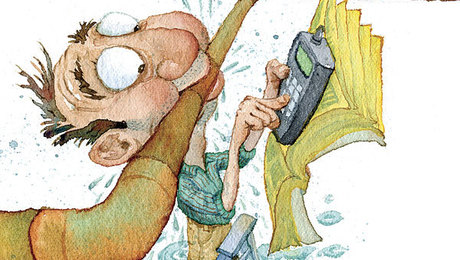Murphy’s Fun House
Great moments in building history: Please pardon Mr. Murphy
I have heard of Murphy and his infamous law, but until recently, they had never affected my business as a general contractor. In the past 12 years I have developed a successful business with a reputation as a perfectionist who is deeply concerned about client satisfaction. I make this point not to brag, but to set up my own demise.
My clients, Bob and Amy, wanted me to build a weight room in one stall of a four-car garage on their estate in Los Angeles, California.
It was a straightforward task that I knew could be completed in a week. I had all my ducks in a row on this job, and I anticipated a better-than-average profit. The clients flew to France for the holidays, and I jumped into a perfectly planned, one-week job.
Thursday we framed the room. Friday the electricians installed the rough wiring. Saturday the room was plastered. Monday I started installing the French doors and doing the other finish work. Tuesday and Wednesday were the Christmas holidays, and Thursday $1,500 worth of mirrors were installed. Friday the carpet went in, and Saturday I took off for a week’s vacation, satisfied with a perfectly executed and completed job.
I got back into town on a Saturday; the clients returned on Sunday. That night I got my call.
“Tom, even though it was pouring rain, we ran out and saw the weight room. It looks great; the aesthetics are wonderful,” said Bob. “But Amy wants to know why the floor isn’t level.”
Anxiety was buzzing my body, and my head felt as though it was expanding.
“Well,” I said, “Frank (Amy’s personal trainer) and I discussed the slope of the garage floor, and he said it wouldn’t be a problem. He said the equipment could be shimmed.”
Amy replied, “It really bothers me to walk into a room and have the floor slope uphill. Doesn’t it seem awkward to you that it slopes uphill?”
In fact, I had thought of asking them about leveling the floor, but after discussing it with Frank I let it go. This was the beginning of a horrendous week. We agreed that the floor should be level, and because it wasn’t mentioned in the original bid, Bob and Amy would pay for the extra work.
Because the slope of the floor went from zero to about 4 1⁄2 in. over 20 ft., I came up with the brilliant plan of pouring a four-sack slurry mix, which contains only sand and cement, allowing me a smooth transition from old to new. I had never used slurry before, but it seemed like a smart idea. Not so.
Slurry mix has a lot more water in it than a normal concrete mix does, and because I was pouring over a slab there was no place for the water to go. As the pumper took his place at the hose on the day of the pour, I could tell even he was a little apprehensive at what he saw.
There I was, trying to screed something that had the consistency of turkey gravy when the mix abruptly stopped flowing from the hose.
“That’s not all there is!” I screamed. “There’s got to be more, right?”
“I’ll go check”, he said.
After fixing a clog in the pump, the pumper returned, and we started again. I was so relieved that I actually started to laugh about the whole scene when the hose once again stopped delivering its load. Now it was the pumper’s turn to get a little uptight.
He ran out and came back a minute later. “We’re out of mud,” he said.
I felt my head expanding again. From what I could see we were 1⁄4 yd. to 1⁄2 yd. short. I figured there had to be quite a bit of concrete in the 200 ft. of hose and asked the pumper to pump it out. He agreed but warned me to hold on tightly because he would have to run the pump at full throttle. He also warned me to signal him as soon as I saw water exiting the hose.
The pump spewed the remaining mud at an alarming rate, and by the time I signaled my co-worker Ron to tell the pumper to stop, there was enough water shooting from that 4-in. hose to douse a three-alarm fire.
It was noon when the pumper had cleaned up and left; it was 5:30 when I finished hand-mixing 16, 90-lb. bags of cement, drained 25 gal. of water off the top of the slab with a 4×6 sponge and troweled the surface. I left the job that evening feeling worn out but glad that it was over—the worst was behind me.
But Murphy heard my thoughts.
The next day I returned to the job refreshed and ready to finish. Amy came down to have a look, and we started discussing the height of the ballet bar. Because of the new slab, the bar was now too low. I told Amy before I poured the concrete that the bar would be lower, which did not seem to bother her then but was now unacceptable. I felt my head expanding again. In good faith I agreed to have the mirror above the ballet bar cut down, allowing me to put in an oak mounting board 7 in. wide instead of 3 1⁄2 in. She didn’t like this because they were spending a lot of money on that weight room, and it should be exactly what they were hoping for. She was nice enough, however, to let it go.
I arranged for the glass company to come out the next day and cut the mirror. In preparation for this I removed the ballet bar and mounting board, which left a mirror on the bottom, a gap in the middle where the ballet bar had been, and another mirror on top. At one end, a third mirror butted against the other two, running from floor to ceiling. The mastic used to glue the mirrors held firmly, so I decided not to block the top piece of mirror, which had been resting on the oak mounting board. Then I turned the heater on because I was a bit chilly. Three hours later I was working outside and heard a clunk from inside the room. I was used to the pressure by this time and did not notice my head expanding. I knew what had happened before I saw it—the mastic had softened from the heat, allowing the top mirror to slide down the wall. I ran into the room and noticed three very small chips in all three pieces of mirror. The entire 100 sq. ft. of mirror was ruined. Amy was going to get her ballet bar exactly where she wanted it.
I did finish the weight room—five weeks after I started it. I am grateful that it was a small job on which I was exposed to the exponential problems that can occur from one error in judgment. The most important lesson for me? When your ducks are all in a row, watch out for Mr. Murphy. He’s hunting those ducks, and if you give him the chance, he’ll blow them away.
—Tom Montgomery, North Hollywood,Calif.
Fine Homebuilding Recommended Products
Fine Homebuilding receives a commission for items purchased through links on this site, including Amazon Associates and other affiliate advertising programs.

Affordable IR Camera

8067 All-Weather Flashing Tape

Handy Heat Gun


























